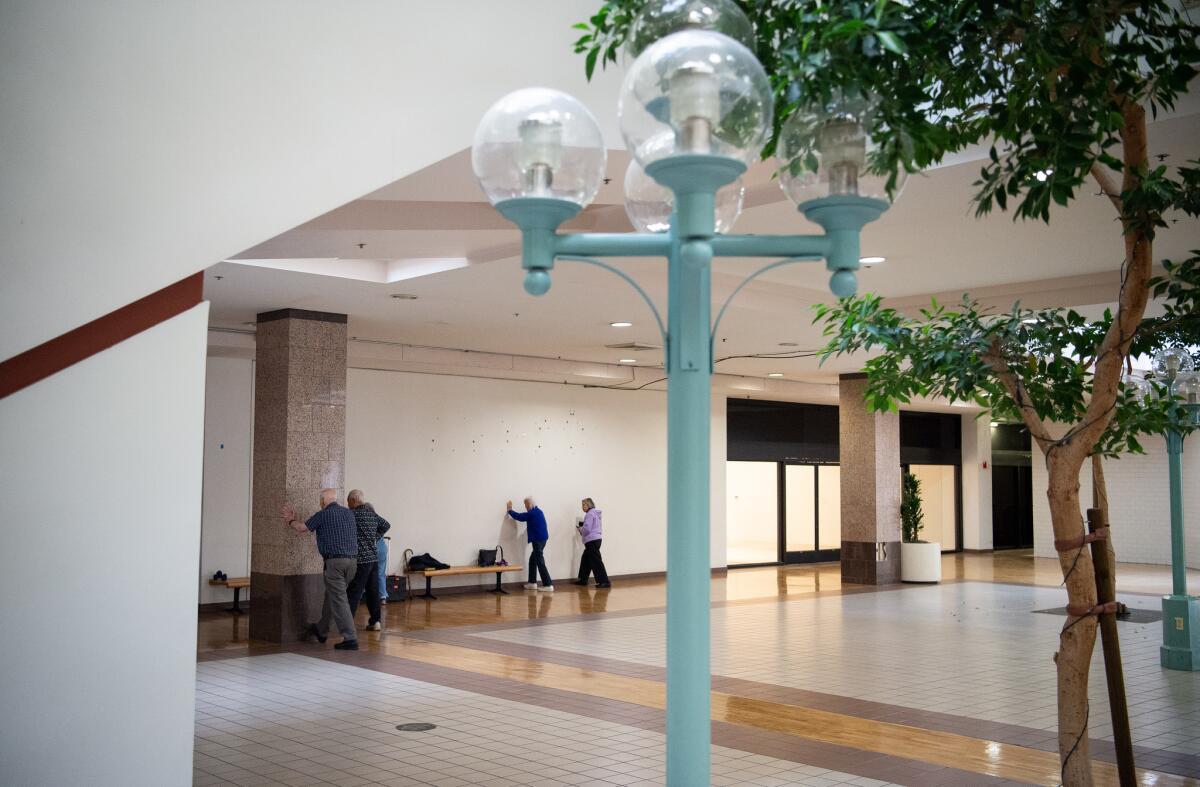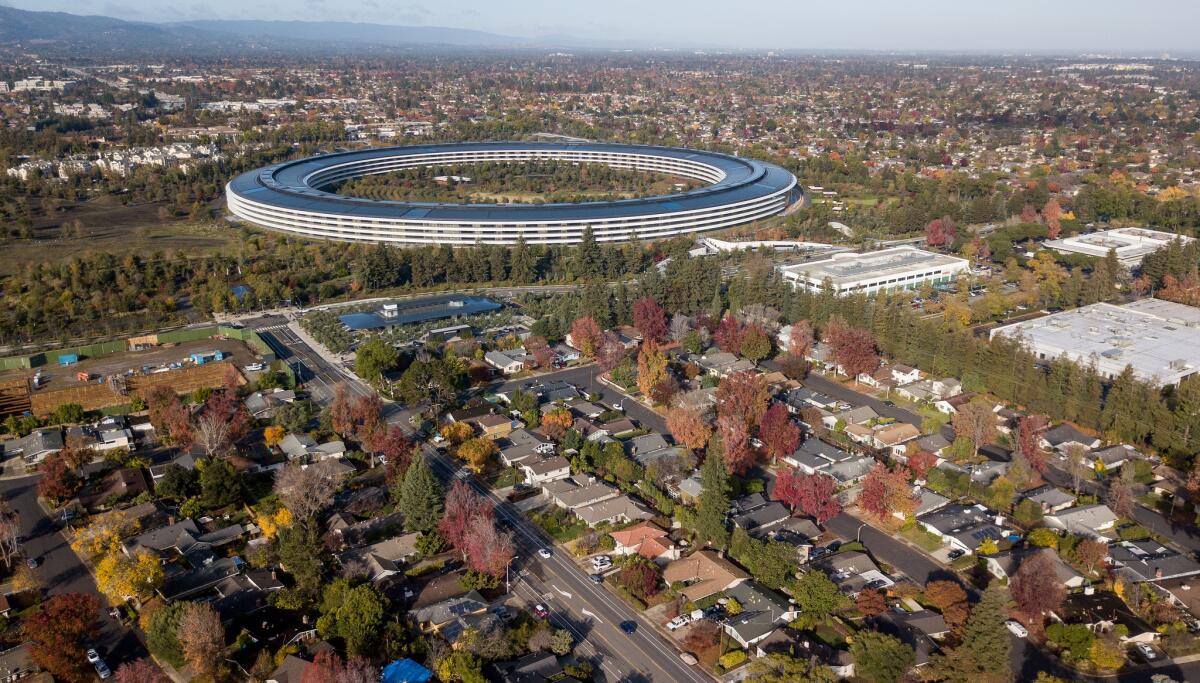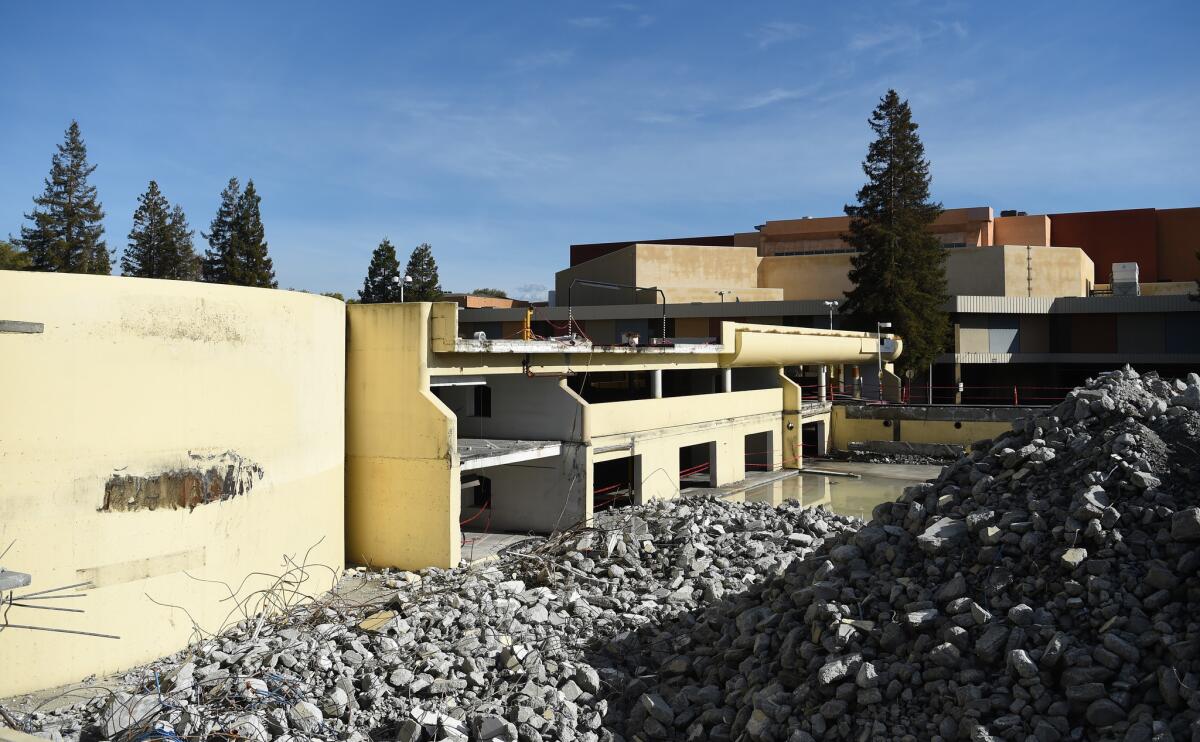New law could break the stalemate over housing on the site of a near-vacant Cupertino mall

- Share via
Reporting from Cupertino, Calif. — For more than a decade, developers have tried to build new housing on the site of an all-but-empty mall in Cupertino, a city in the heart of Silicon Valley and home to Apple headquarters. A well-organized group of neighbors, upset about traffic, building heights and the potential loss of the community’s suburban lifestyle, turned away every plan.
Now, for the first time, the stalemate might be broken — thanks to a decision made in the state Capitol.
In an effort to address California’s housing affordability problem, legislators passed a law last year that requires cities and counties to approve housing projects if they comply with local zoning rules and other standards, forcing some resistant communities to agree to new homebuilding. In September, the city of Cupertino, citing the state law, approved developer Sand Hill Property Co.’s proposal to build an office park and more than 2,400 homes where the Vallco Shopping Mall sits.
If the project is built, state officials say the law will have done what it was designed to: End local gridlock to facilitate housing development in one of California’s most unaffordable places.
“This is what we wanted to see happen,” said Sen. Scott Wiener (D-San Francisco), the author of the law, Senate Bill 35.
But the development’s approval has only intensified debate over the mall’s future, an issue that has taken over local politics in Cupertino. Vallco’s fate has prompted lawsuits, tumult within city bureaucracy, a referendum campaign and elections that resulted in a new City Council majority that is against Sand Hill’s efforts. The acrimony shows few signs of abating.
“I feel sad that highly intelligent, resourceful and passionate leaders on both sides could not figure out a peaceful way to solve conflicts together,” said Minh Le, 65, a conflict-resolution consultant briefly considered to lead mediation efforts over the mall’s future. “Instead they contributed to tearing to shreds the fabric of our community in this fight over who gets to decide what happens at Vallco.”
Like its neighbors in Silicon Valley, Cupertino has seen a spike in home prices alongside the tech industry’s job growth. Cupertino, a city of 61,000, has a median home value of $2.3 million, according to real estate website Zillow, a 132% increase since 2010.
The Vallco property, which has 1.2 million square feet of retail space, once functioned as Cupertino’s de facto downtown. But it has been on the decline for years. Its vast corridors now are filled with the remnants of a Radio Shack electronics shop, an abandoned diner and numerous other vacant storefronts.
Developers have made multiple attempts to revamp the retail center to include housing, but their bids attracted resistance from those who felt doing so would unalterably change the community.
A 2006 effort to add 137 homes on the site was branded “Condotino” by opponents, who defeated it at the ballot box. A decade later, voters rejected a plan from Sand Hill to build up to 800 homes and add office space, as well as a separate initiative backed by a community group called Better Cupertino that would have blocked offices or housing on the site.
The loss of both initiatives in November 2016 left the future of the property at an impasse. But the debate would soon take a dramatic turn thanks to the state Legislature.


As part of a package of bills written in 2017 to address rising housing costs, SB 35 is supposed to make it easier for homes to be built. The legislation requires cities to approve projects if they meet a number of requirements, including complying with local zoning regulations and reserving a certain percentage of a development for low-income residents.
So far, a handful of projects in the Bay Area have been approved under the law.
Sand Hill Managing Director Reed Moulds said the company eyed the bill as it worked its way through the Legislature and hoped it would help its plans for Vallco.
“We always knew that those same forces that caused the original project to be delayed continued to be involved in Cupertino policymaking and would not go away,” Moulds said. “We were well aware of this contingency plan.”
Sand Hill came up with a big proposal: 2,400 new homes with half reserved for low-income residents, per the law’s requirements — an amount that would nearly quintuple the low-income housing available in Cupertino. Sand Hill would also build 1.8 million square feet of office space, which would boost the total in the city by more than 15%. The proposal includes seven 22-story towers, dwarfing other buildings in Cupertino.
As Sand Hill was preparing its plan, the city decided to make an attempt at passing a version of the project on its own.
After nearly a year’s worth of meetings, the city came up with a proposal that had more homes — but fewer reserved for low-income residents — slightly less office space and shorter buildings. As part of the deal, Sand Hill would have to build Cupertino a new city hall and a performing arts center. The developer said it preferred the city’s version of the Vallco redevelopment over the one authorized under state law and agreed to back it. Cupertino’s City Council voted 3-2 in September in favor of the plan the city developed.
The city’s approval of two separate Vallco proposals — the one required by state law and the other envisioned by local officials — has been met with outcry from opponents, including Better Cupertino. The group grew more resolute as the Vallco plans advanced, forming a nonprofit to challenge the project in court and a political action committee to fight it at the ballot box.
The group believes Sand Hill’s plans concentrate too much development in one place and that the city should instead encourage a number of smaller housing projects across Cupertino.
“People don’t object to the housing projects that fit the character of Cupertino,” said Liang Chao, one of Better Cupertino’s founders and a newly elected city councilwoman.
The group sued over Vallco’s approval under the new state law, saying the plan’s specifics make it ineligible. Better Cupertino also collected enough signatures to force a voter referendum over the council-approved version of the project.
The organization gained another significant victory last month when Chao won a City Council seat. A second candidate backed by Better Cupertino also appears to have secured a seat by a narrow margin, pending a recount. If the results hold, the two new members would turn the council into a 4-1 majority against the Sand Hill development.
Better Cupertino wants the new council to do everything it can to stop the project from happening, including investigating claims of a former city attorney who alleges that he was dismissed from his job because he didn’t believe Sand Hill’s project qualified under state law.
Meanwhile, Moulds says Sand Hill has withdrawn its support for the council-approved version of the project because of the referendum. He said Sand Hill is going ahead with the proposal allowed under state law, even though the council now has turned against it.
“We expect the council members who were just elected to be at the ribbon-cutting of our first phase [of the project] in the next four years,” he said.
But the developer has given signs the company is not happy with the current situation.
While Better Cupertino was collecting signatures for the referendum against the council-approved plan, Sand Hill hired people to stand next to volunteers and attempt to dissuade residents from signing. The developer also mailed out advertisements that argued against the state version of the project Sand Hill now says it intends to build.
“Do you really want Sacramento politicians to decide the future of Vallco?” the advertisement said.
The opposite side of the ad repeated many of opponents’ arguments against the state version of the Vallco plan, noting the height of the 22-story towers and that the project would provide plenty of low-income housing but no homes for teachers, nurses, police officers or firefighters.
Le, the conflict-resolution specialist who has lived in Cupertino for more than three decades, said the hurt in the community over Vallco could last years no matter the project’s fate.
“It’s like a great Greek tragedy,” Le said. “I feel sorry for everyone. No one gets what they want — even when they think they’re winning.”
Coverage of California politics »
More to Read
Get the L.A. Times Politics newsletter
Deeply reported insights into legislation, politics and policy from Sacramento, Washington and beyond. In your inbox three times per week.
You may occasionally receive promotional content from the Los Angeles Times.











